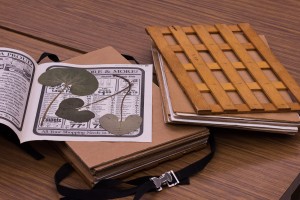In 1884 Edwin Abbott published a satirical novel about Victorian life entitled “Flatland: A Romance of Many Dimensions” in which he described a fictional two-dimensional world and one character who realizes that a third dimension exists – but is unable to persuade others. In many ways the Herbarium collections belong to such a world – after all, unlike all of the other collections in our Museum, the Herbarium consists largely of plants that have been robbed of one of their dimensions!
Why is this? Nobody would think of flattening a whole insect or a squirrel or a fish as a method of preservation. What is it that all of them have that plants do not have? A skeleton. Whether on the inside (endo-) like we have, or on the outside (exo-) as arthropods have, many animals have a skeleton that allows them to keep their shape even when dead. Remember that vase of roses that dried out while you were away on vacation, only to present itself as a withered and curled jumble of brittle parts when you returned? That’s what would happen if we allowed plants to dry as three dimensional objects.
This situation leaves us with two choices: either we preserve plants in a liquid such as alcohol or we press and dry them. Liquid preservation would keep the third dimension, but liquid (“spirit” as they are often called) collections are care-intensive in that the fluids must be constantly checked to be sure that they do not evaporate. Maintaining jars with fluid also takes a significant amount of space. Lastly, even in a preservative fluid plant tissues eventually begin to disintegrate, so it is not the best choice for the long term. The standard method of pressing and drying plant specimens was established long ago and it is a good compromise.
Pressing is an essential part of the drying process because it keeps the tissues from experiencing the distortion that differential loss of water would otherwise cause (remember those withered roses?). The majority of a plant’s body is made up of cellulose – it’s the fibrous part that you cannot digest – and this provides structure to the plant while alive and also when it is dried. The lack of such a handy molecule is the reason that we cannot just dry those animals that do not have some sort of skeleton – invertebrates such as sea anemones, worms, and many others. They are largely protein and fats in composition and those molecules just do not provide structure. They dry to a useless blob of crispy tissue. Think of those dried squid pieces from your local Asian foods grocer – can you imagine trying to study those?
So we press and we dry. The faster we dry, the better, in terms of preserving colors and also molecules that we might be interested in, such as DNA. Today, herbarium collections are a valuable source of DNA for comparative studies, so we do think about trying to preserve specimens for that use. Even when dried carefully, a plant specimen’s colors will eventually fade and of course features such as floral scent do not preserve, which is why it is important to note any aspects of the plant that might not last on the label that accompanies the specimen.
And it works – we are essentially turning the plant into paper and as long as the specimen is kept dry and away from insects that might eat it, it should keep indefinitely.
The earliest plant specimens in existence are from the mid-1500’s and they are doing just fine. In fact, the oldest herbarium collection is at the Natural History Museum in Kassel, Germany, where the oldest specimens are bound in books, as they were typically in the early days. Here at OSU the oldest plant specimens in our collection are from 1839-40, collected by William Starling Sullivant from the area around Columbus. Today there are tens of millions of herbarium specimens worldwide, all preserved in this way, many now being imaged and databased for easy remote access.
But we still miss that third dimension. Students sometimes express frustration in getting used to looking at pressed plants. I have been doing it for so long that it is second nature. But I can remember at first trying to relate that flattened object to something living – it was challenge. And it still can be. It turns out that some species differ in rather subtle ways that involve orientation of floral parts that is completely obscured in pressing. Luckily, some flowers can be rehydrated by removing from the specimen and just bringing to a boil in a little water.
Some flowers essentially spring right back into three dimensions when this is done, which is great. Unfortunately, not all do. Some flowers are very thin-textured and although they dry just fine, trying to rehydrate them results in a shapeless mass of mush. Not surprisingly, those groups are often the ones that have not been worked on scientifically because so much of the study needs to be done in the field, with specimens being less useful. An example of flowers that do not rehydrate well is our North American genus Trillium because the petals have a very thin texture.
In the end, any method of preservation of an organism will result in some loss of information. However, we can learn so much from what we do preserve and our collections can so broadly extend sampling beyond what any one person could ever see in the field. So we live with our limitations and, unlike the Flatlanders, we believe that there are many more dimensions waiting for us out there in the field.
About the Author: Dr. John Freudenstein is a Professor in the Department of Evolution, Ecology and Organismal Biology and Director of the OSU Herbarium. All photos are by the author.



